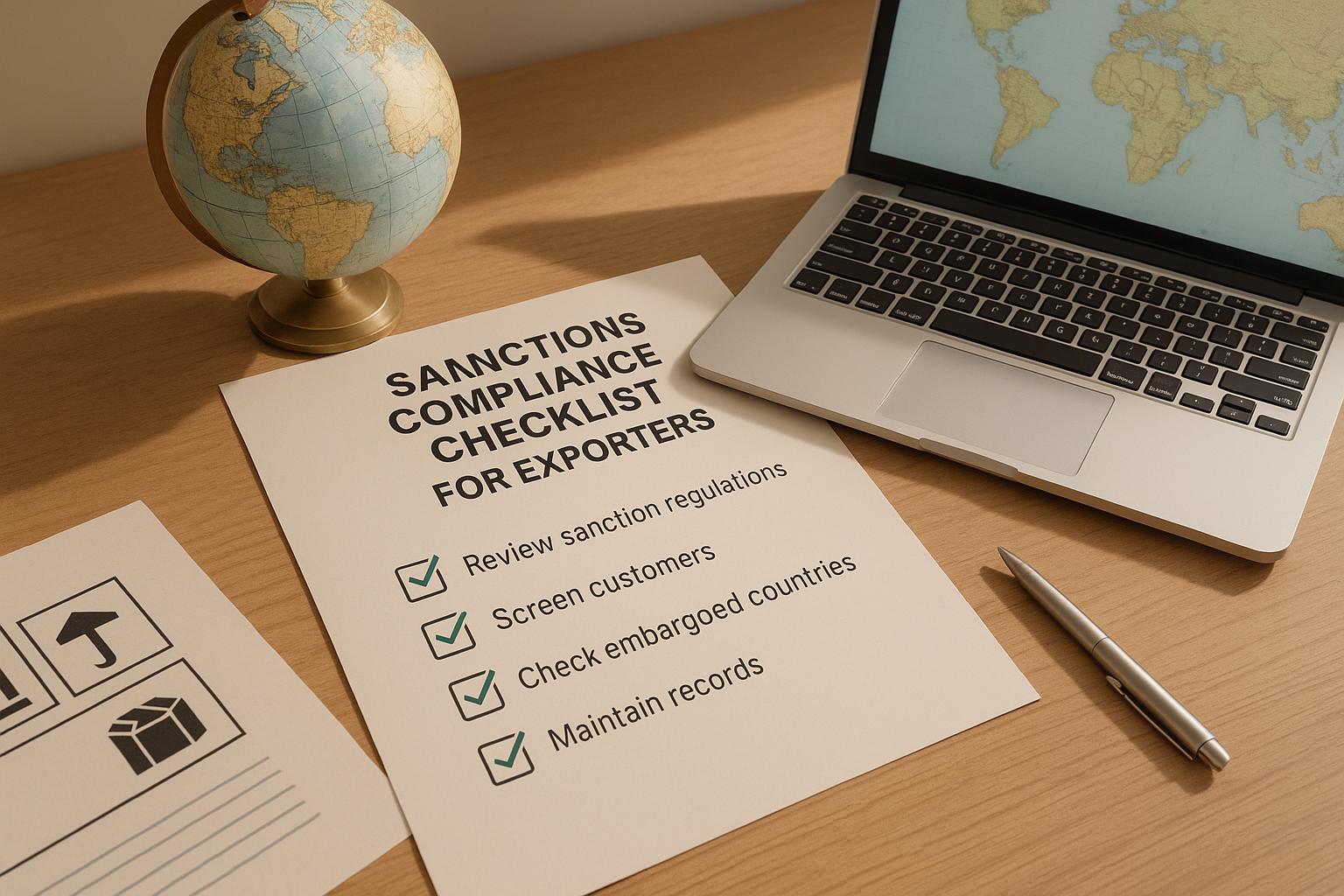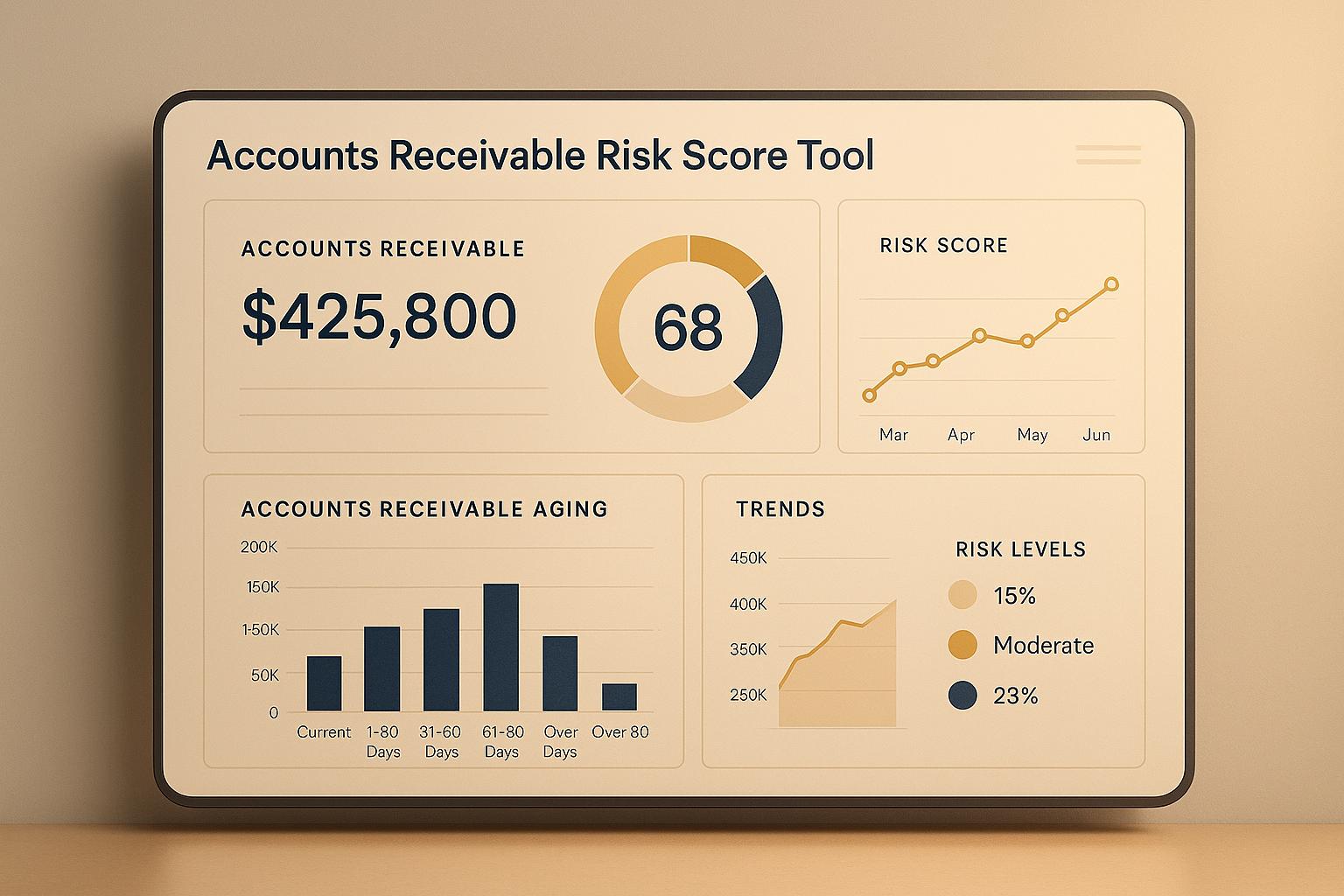Trade credit insurance is a must-have for U.S. businesses in 2025, offering protection against non-payment risks and ensuring cash flow stability. Here’s what you need to know:
- Market Size & Growth: The U.S. market was valued at $2.02 billion in 2023, with a projected CAGR of 10.6% through 2030, reaching $4.07 billion.
- Coverage: Policies cover up to 95% of losses from commercial or political risks, with premiums costing less than 1% of insured sales.
- Global Context: Insured shipments globally hit $7 trillion with a market penetration rate of 13.16%.
- Key Trends: AI, blockchain, and digital platforms are transforming risk assessment and policy management.
- Challenges: Insolvencies are rising, with sectors like construction, retail, and transportation facing heightened risks.
Takeaway: Trade credit insurance is growing rapidly, driven by technological advancements and increasing awareness of credit risks. Businesses should integrate digital tools and customize policies to navigate today’s complex risk landscape.
Market Growth Analysis
2025 Market Statistics
The U.S. trade credit insurance market is on track for significant growth in 2025. In 2023, the market size reached $2.02 billion, with an expected compound annual growth rate (CAGR) of 10.6% from 2024 to 2030. The U.S. also contributed 19.04% of the global market’s revenue in 2023. Meanwhile, the global trade credit insurance market reported a total premium volume of $13.89 billion in 2022.
| Market Indicator | Value |
|---|---|
| U.S. Market Size (2023) | $2.02 billion |
| Global Premium Volume (2022) | $13.89 billion |
| U.S. Market Share | 19.04% |
| Projected CAGR (2024–2030) | 10.6% |
| Global Insured Shipments | $7 trillion |
These numbers highlight the market’s strong foundation and point to the factors driving its growth.
Market Growth Factors
Several trends and developments are fueling this expansion:
Technology Integration
The use of advanced data analytics and artificial intelligence is transforming risk assessment. Insurers now provide more tailored coverage options, improving both risk management and pricing precision.
Digital Transformation
Digital platforms are streamlining policy management, making trade credit insurance more accessible to businesses of various sizes. Blockchain technology is also enhancing transparency and security in policy transactions.
Economic Factors
Rising global trade, increased awareness of credit risks, and stable trade policies are driving demand for risk protection solutions.
Industry Innovation
Collaborations between insurers and fintech companies are creating bundled solutions that improve efficiency and expand market reach.
These factors collectively set the stage for continued growth in the U.S. trade credit insurance market, which is projected to reach a value of $4.07 billion by 2030.
Current Trends and Technology
Digital Tools and Blockchain Impact
The trade credit insurance industry is experiencing a major shift thanks to digital advancements. AI and machine learning are transforming credit underwriting. For instance, Atradius now handles 20,000 credit applications daily through automation, enhancing efficiency without compromising underwriting standards.
Blockchain is tackling inefficiencies that result in over $1 billion in annual losses. By using smart contracts, claims processing and payouts are automated when specific conditions are met, reducing delays and manual errors.
"Blockchain technology is being used across the insurance industry to automate claims processing and payouts, reducing manual intervention and speeding up settlements." – Shaun Richards, Head of Enterprise Architecture, Towergate Insurance
One standout example is the collaboration between AIG, Standard Chartered, and IBM in 2021. They piloted a smart contract-driven policy for multi-risk transfer across multiple jurisdictions. These advancements are laying the foundation for new policy innovations, which are explored in the next section.
Policy Types and Options
With digital tools reshaping risk management, modern trade credit insurance policies now offer features like:
| Feature | Benefit |
|---|---|
| Multi-buyer Coverage | Protects a wide range of customers under one policy |
| Digital Policy Management | Enables real-time risk tracking and automated compliance |
| Customized Limits | Offers tailored coverage to meet specific business needs |
| Syndicated Solutions | Expands capacity by involving multiple insurers |
These features are increasingly important as businesses navigate evolving challenges. Nicolas Garcia, Group Commercial Director at Coface, highlights this progress:
"We have proven ourselves over recent years, particularly if you consider the number of crises over the last four years and the resilience and intelligence we have been able to bring for our clients."
As these advanced policies gain traction, regulatory updates in the U.S. are shaping how the market operates.
U.S. Regulation Updates
The rise of digital tools has led to updated regulations aimed at improving transparency and risk management. For example, the integration of IoT devices for automated data collection has introduced new compliance requirements for insurers. These changes are helping create a more secure and efficient marketplace.
Jim Toffey, CEO of LiquidX, underscores the importance of these regulatory shifts:
"This is a watershed moment for trade credit insurance. We built LiquidX’s digitization technology to do the hard work of digitizing and automating manual processes across the entire working capital ecosystem. Trade credit insurance, which has traditionally been user-intensive and not integrated into finance systems, is a great use case for LiquidX’s digitization technology."
Industry Examples
Manufacturing and Export Solutions
Trade credit insurance plays a crucial role for U.S. manufacturers and exporters looking to expand globally while mitigating payment risks. Take Graceland Fruit, Inc., a Michigan-based fruit processing company, as an example. By leveraging export credit insurance, the company significantly grew its international business. Between 2014 and 2018, its insured export shipments increased from $24 million to $42 million – a 75% jump.
Al DeVore, CEO of Graceland Fruit, highlighted the importance of trade credit insurance:
"EXIM is a vital part of our business. It helps to open a critical path to international business that a smaller company like ours might not otherwise have access to."
Today, Graceland Fruit exports to 65 countries, with exports making up about 60% of its revenue. This international growth has also led to job creation at its Michigan and Wisconsin processing facilities.
In another case, a mid-sized electronics manufacturer faced challenges due to reduced carrier limits. AIG Trade Credit stepped in with a customized, non-cancelable program tailored to the company’s needs. This solution allowed the business to continue operating with confidence.
| Benefits | Impact on Business |
|---|---|
| Coverage up to 95% of invoice value | Lower financial exposure |
| Protection against buyer insolvency | Better risk management |
| Political risk coverage | Safer international expansion |
| Extended payment terms capability | Boosted competitiveness |
These examples show how tailored insurance solutions can address the unique needs of various sectors, including small and medium-sized enterprises (SMEs).
SME Coverage Options
For SMEs, managing credit risks is critical, especially since around 25% of businesses fail due to customer non-payment. To address this, specialized trade credit insurance options have been developed to protect SMEs from such risks.
One example is CoverCredit, a solution created through a partnership between Marsh and Coface. It offers SMEs a range of services, including credit insurance, assessment tools, and collections management. These services help businesses safeguard receivables and maintain steady cash flow.
Another option is EXIM Bank’s Express Insurance program, designed specifically for small exporters. This program offers several advantages:
| Feature | Benefit |
|---|---|
| No application fees | Easier access for small businesses |
| No minimum annual premium | Flexible and cost-effective |
| Free credit reports | Better-informed risk decisions |
| $500 refundable deposit | Low upfront costs |
| Streamlined application | Faster approval process |
For those seeking broader protection, Coface offers the TradeLiner policy. This policy secures B2B sales both domestically and internationally, with simplified pricing and terms.
These tailored solutions provide SMEs with the tools they need to manage credit risks effectively and grow their businesses confidently.
sbb-itb-2d170b0
Market Challenges
Credit Risks by Sector
In 2025, trade credit insurance is increasingly shaped by challenges unique to specific industries. Over the 12 months ending March 31, 2024, insolvencies surged by 40%.
| Sector | Key Risk Factors | Impact |
|---|---|---|
| Construction | Rising interest rates, higher material costs | Increased insolvencies |
| Retail | E-commerce competition, reduced consumer spending | Payment defaults |
| Transportation | Supply chain issues, rising fuel costs | Operational struggles |
| Commercial Real Estate | Forecasted delinquency increase (8.1%) | Greater credit exposure |
Additionally, the Middle East conflict caused a 50% drop in Suez Canal traffic in March 2024.
"At the beginning of last year, the trade credit industry faced one of the largest claims ever on one of the Brazilian retailers. We’ve seen a number of construction companies failing in 2023 and also retail in other countries due to structural changes…such as the move to ecommerce"
Given these mounting risks, businesses need to strengthen their risk management approaches.
Risk Management Methods
With sector-specific risks on the rise, companies are leaning on modern, data-driven methods to manage credit risks. A mix of traditional tools and digital technologies is becoming essential. According to a Creditsafe study, 37% of finance managers identified poor automation as a major concern.
Key strategies include:
- Digital Integration Businesses should upgrade their credit assessment processes using AI-powered scoring models and automated validation tools. Automation is critical, especially when 58% of respondents report spending 1–4 hours daily on manual sales data entry.
- Data-Driven Decision Making
"The level of uncertainty and the complexity has been at the highest level for at least the last decade. The tensions on the macro-economic and the political sides are huge."
To navigate this uncertainty, companies can adopt:
Strategy Implementation Benefit Real-time monitoring AI-based risk assessment Early identification of risks Payment data sharing Reporting to credit bureaus Strengthened credit networks Supply chain diversity Partnering with multiple suppliers Lower dependency risks Digital validation Automated KYC systems Better fraud prevention
These approaches directly address the challenges facing industries like construction, retail, and transportation.
The U.S. Department of Justice predicts bankruptcy filings will double over the next three years. For industries like technology and AI, additional measures such as strong data privacy and cybersecurity systems are crucial. Companies with robust risk management practices are more likely to secure the coverage they need.
Summary
Main Points Review
By 2025, the market is projected to be 25% larger compared to 2019, with insurers covering approximately 75% of risks. Key market trends include:
| Market Aspect | 2025 Status | Impact |
|---|---|---|
| Economic Resilience | Strong employment rates | Growth opportunities increase |
| Digital Integration | AI-powered solutions | Risk assessment becomes faster |
| Premium Rates | 1.5-2% decrease in Q1 2024 | Greater accessibility |
| Market Penetration | Expanding in the U.S. | Broader coverage options |
U.S. businesses increasingly view trade credit insurance as a strategic asset, offering both protection and actionable market insights.
"Despite challenges, the future of credit insurance in the US looks positive. Regulatory reform, digitisation, and adaptability are key to capitalising on the current growing needs, and to laying strong foundations for a sustainable future for the industry." – Benjamin Le Forestier
With these market dynamics in mind, businesses need to adopt focused strategies to improve their risk management approach.
Next Steps
Strategic planning in 2025 is crucial for integrating trade credit insurance effectively. The rise in insolvencies and advancements in digital tools present both challenges and opportunities.
Focus on:
- Risk Assessment Integration: Use real-time monitoring tools to strengthen credit management practices.
- Digital Adoption: Introduce AI-driven platforms to improve risk analysis and decision-making.
- Policy Customization: Tailor coverage to fit specific industry risks and growth goals.
These actions align with the evolving market and technological changes.
"Trade credit insurance protects your account receivables, enabling you to trade, expand domestically and abroad without the risk of bad debt." – Allianz Trade US
The market’s growth prospects remain strong as businesses look for ways to safeguard against rising insolvencies. Combining traditional risk management with modern digital solutions can ensure solid protection and maintain a competitive position.
Credit Insurance as a Risk Mitigation Tool for International Trade
FAQs
How are AI and blockchain transforming risk assessment and policy management in trade credit insurance?
AI and machine learning are revolutionizing risk assessment by analyzing large datasets, such as market trends and borrower behavior, to deliver more accurate and real-time evaluations of credit risk. These technologies enhance decision-making by identifying patterns and providing insights that traditional methods might overlook.
Blockchain, on the other hand, improves transparency and security in policy management. By enabling real-time data sharing and verification across multiple stakeholders, it helps ensure accurate tracking of supply chain dependencies and reduces the risk of fraud. Together, AI and blockchain are driving smarter, more efficient processes in trade credit insurance.
How can U.S. businesses use digital tools and customize trade credit insurance policies to address unique industry risks?
U.S. businesses can enhance their use of trade credit insurance by incorporating digital tools that streamline processes, improve risk evaluation, and enhance fraud detection. Advanced platforms can provide real-time insights into credit risks, helping businesses adapt to shifting market conditions and emerging challenges.
By customizing policies, businesses can tailor coverage to meet specific needs – whether for their entire accounts receivable portfolio, individual buyers, or specific transactions. This flexibility not only helps mitigate financial risks but also supports better cash flow management and strengthens overall financial resilience.
How are rising insolvencies in industries like construction and retail shaping trade credit insurance policies in 2025?
In 2025, rising insolvencies in sectors such as construction and retail are expected to have a significant impact on trade credit insurance. While insolvencies are forecasted to decrease by 6%, they will likely remain 30% higher than pre-pandemic levels, creating a challenging environment for businesses. These conditions are prompting insurers to refine their policies, focusing on sector-specific risks and offering more customized solutions to address evolving needs.
Despite these challenges, the market for new policyholders remains competitive, with favorable pricing for businesses entering the trade credit insurance space. Companies in vulnerable sectors can leverage these policies to mitigate financial risks and protect against potential losses in an uncertain economic climate.



